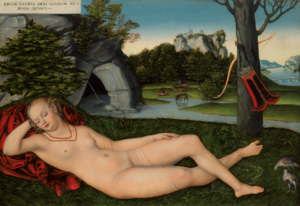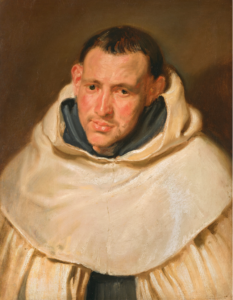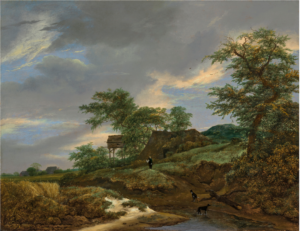
The Nymph of the Spring by Lucas Cranach the Elder
On Thursday, July 7th, Christie’s London hosted its Old Masters sale, capping off a string of Old Masters sales held the previous week at London’s other major auction houses. While the sale did rather well, there were a few disappointing moments.
The sale’s top lot was The Nymph of the Spring by Lucas Cranach the Elder. It initially seemed a little underwhelming, not much different from some of the other Renaissance and Baroque nudes by masters like Titian or Rubens. But the more I read about it, the more I understood that multi-million pound price tag. Mythical nudes were a common subject for Cranach, who created twelve different works entitled Nymph of the Spring. This one, however, is the largest of the bunch, measuring almost three feet by four feet. While Cranach’s first works featuring the reclining, nude nymph date to around 1518, specialists can date this particular nymph to about 1540 to 1545. This is known because of a small white symbol painted on the tree in the foreground: a winged serpent, which Cranach used as his signature starting around 1537. The work also has an incredible provenance. It appears to have been in the Holy Roman Emperor Rudolph II’s collection before being looted by Swedish troops at the end of the Thirty Years’ War in 1648. Afterward, it was placed in the collection of Sweden’s Queen Christina, one of the most interesting women of early modern Europe. For several centuries, it remained in Sweden, bouncing around between several prominent collections, including that of Count Gustav Adolf Sparre, one of the top art collectors of the eighteenth century; it finally ended up in a UK collection. Bidding for the Cranach stopped at its high estimate, with the hammer coming down at £8M / $9.6M (or £9.5M / $11.3M w/p).

Portrait of a Carmelite Monk by Anthony van Dyck
The house specialists’ predictions also proved correct regarding the Anthony Van Dyck Portrait of a Carmelite Monk. Like the Cranach nymph, the Carmelite Monk also has an interesting provenance. Not long after its creation, it was bought by one of Van Dyck’s contemporaries, the Flemish master Peter Paul Rubens. The portrait remained the property of Rubens’s descendants until it was sold at Sotheby’s London in 2011 for £713.3K w/p. Whoever bought it back then certainly made a pretty penny since the priestly portrait sold for its low estimate at £2.8M / $3.4M (or £3.4M / $4.1M w/p). Tying with the Van Dyck, Jacob van Ruisdael’s A wooded landscape also brought in £2.8M for Christie’s. The landscape was last sold in 1977 at Sotheby’s Amsterdam location. One issue for anyone looking into that sale is that in 1977 the Netherlands still used the Dutch guilder (ƒ). Nowadays, the guilder is a defunct currency, having been replaced by the euro in 2004. Some research and a little arithmetic led me to guess that the ƒ740K the landscape sold for in 1977 was equal to about $300K at the time (around $1.45M in today’s money).

A wooded landscape by Jacob van Ruisdael
Now, I mentioned that the sale was a little disappointing in some regards. This was mainly because of Antonio Canova’s sculpture Maddalena Giacente, or the Recumbent Magdalene. The work made headlines back in March when Christie’s announced it would be included in this Thursday’s sale. It has an incredible story behind it since it’s considered a rediscovered lost work after spending decades outdoors as a garden statue in west London. House experts at Christie’s expected the statue to reach anywhere between £5M and £8M. However, it became clear that the Canova’s reserve was set at the low estimate because the work was bought in when bidding stalled at £4.8M. This was another example of how a single lot can make or break a sale. Had the Canova sold at £4.8M, the sale would have made its total estimate. However, because it went unsold, the entire sale accumulated £23.2M (or $27.8M), or £1M short of expectations. Twenty-nine of the thirty-five available lots sold, with six selling within estimate and eleven selling over. Not too bad, but still a bit disappointing all because of just one lot.
Christie’s London Old Masters Sale
The Nymph of the Spring by Lucas Cranach the Elder
On Thursday, July 7th, Christie’s London hosted its Old Masters sale, capping off a string of Old Masters sales held the previous week at London’s other major auction houses. While the sale did rather well, there were a few disappointing moments.
The sale’s top lot was The Nymph of the Spring by Lucas Cranach the Elder. It initially seemed a little underwhelming, not much different from some of the other Renaissance and Baroque nudes by masters like Titian or Rubens. But the more I read about it, the more I understood that multi-million pound price tag. Mythical nudes were a common subject for Cranach, who created twelve different works entitled Nymph of the Spring. This one, however, is the largest of the bunch, measuring almost three feet by four feet. While Cranach’s first works featuring the reclining, nude nymph date to around 1518, specialists can date this particular nymph to about 1540 to 1545. This is known because of a small white symbol painted on the tree in the foreground: a winged serpent, which Cranach used as his signature starting around 1537. The work also has an incredible provenance. It appears to have been in the Holy Roman Emperor Rudolph II’s collection before being looted by Swedish troops at the end of the Thirty Years’ War in 1648. Afterward, it was placed in the collection of Sweden’s Queen Christina, one of the most interesting women of early modern Europe. For several centuries, it remained in Sweden, bouncing around between several prominent collections, including that of Count Gustav Adolf Sparre, one of the top art collectors of the eighteenth century; it finally ended up in a UK collection. Bidding for the Cranach stopped at its high estimate, with the hammer coming down at £8M / $9.6M (or £9.5M / $11.3M w/p).
Portrait of a Carmelite Monk by Anthony van Dyck
The house specialists’ predictions also proved correct regarding the Anthony Van Dyck Portrait of a Carmelite Monk. Like the Cranach nymph, the Carmelite Monk also has an interesting provenance. Not long after its creation, it was bought by one of Van Dyck’s contemporaries, the Flemish master Peter Paul Rubens. The portrait remained the property of Rubens’s descendants until it was sold at Sotheby’s London in 2011 for £713.3K w/p. Whoever bought it back then certainly made a pretty penny since the priestly portrait sold for its low estimate at £2.8M / $3.4M (or £3.4M / $4.1M w/p). Tying with the Van Dyck, Jacob van Ruisdael’s A wooded landscape also brought in £2.8M for Christie’s. The landscape was last sold in 1977 at Sotheby’s Amsterdam location. One issue for anyone looking into that sale is that in 1977 the Netherlands still used the Dutch guilder (ƒ). Nowadays, the guilder is a defunct currency, having been replaced by the euro in 2004. Some research and a little arithmetic led me to guess that the ƒ740K the landscape sold for in 1977 was equal to about $300K at the time (around $1.45M in today’s money).
A wooded landscape by Jacob van Ruisdael
Now, I mentioned that the sale was a little disappointing in some regards. This was mainly because of Antonio Canova’s sculpture Maddalena Giacente, or the Recumbent Magdalene. The work made headlines back in March when Christie’s announced it would be included in this Thursday’s sale. It has an incredible story behind it since it’s considered a rediscovered lost work after spending decades outdoors as a garden statue in west London. House experts at Christie’s expected the statue to reach anywhere between £5M and £8M. However, it became clear that the Canova’s reserve was set at the low estimate because the work was bought in when bidding stalled at £4.8M. This was another example of how a single lot can make or break a sale. Had the Canova sold at £4.8M, the sale would have made its total estimate. However, because it went unsold, the entire sale accumulated £23.2M (or $27.8M), or £1M short of expectations. Twenty-nine of the thirty-five available lots sold, with six selling within estimate and eleven selling over. Not too bad, but still a bit disappointing all because of just one lot.